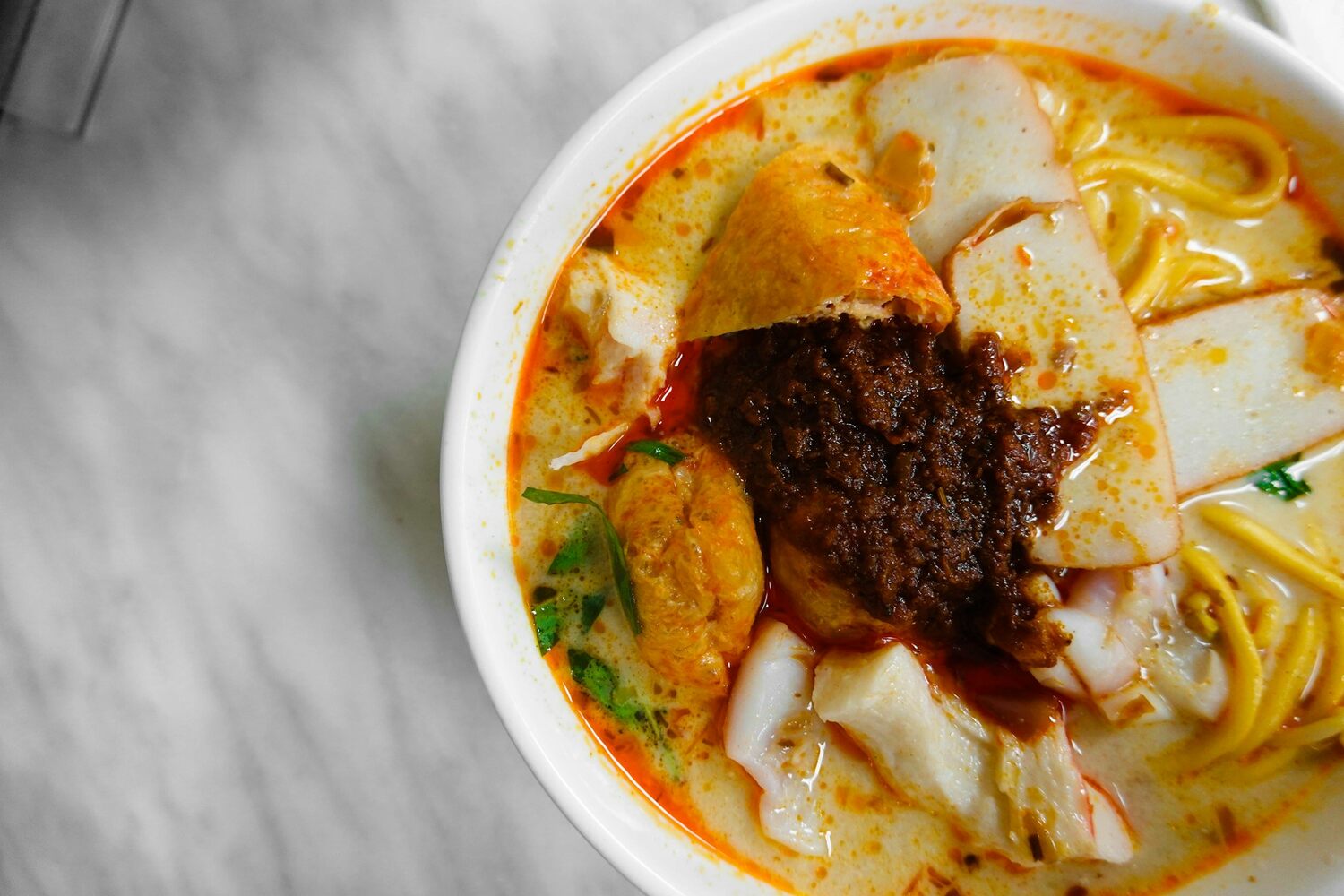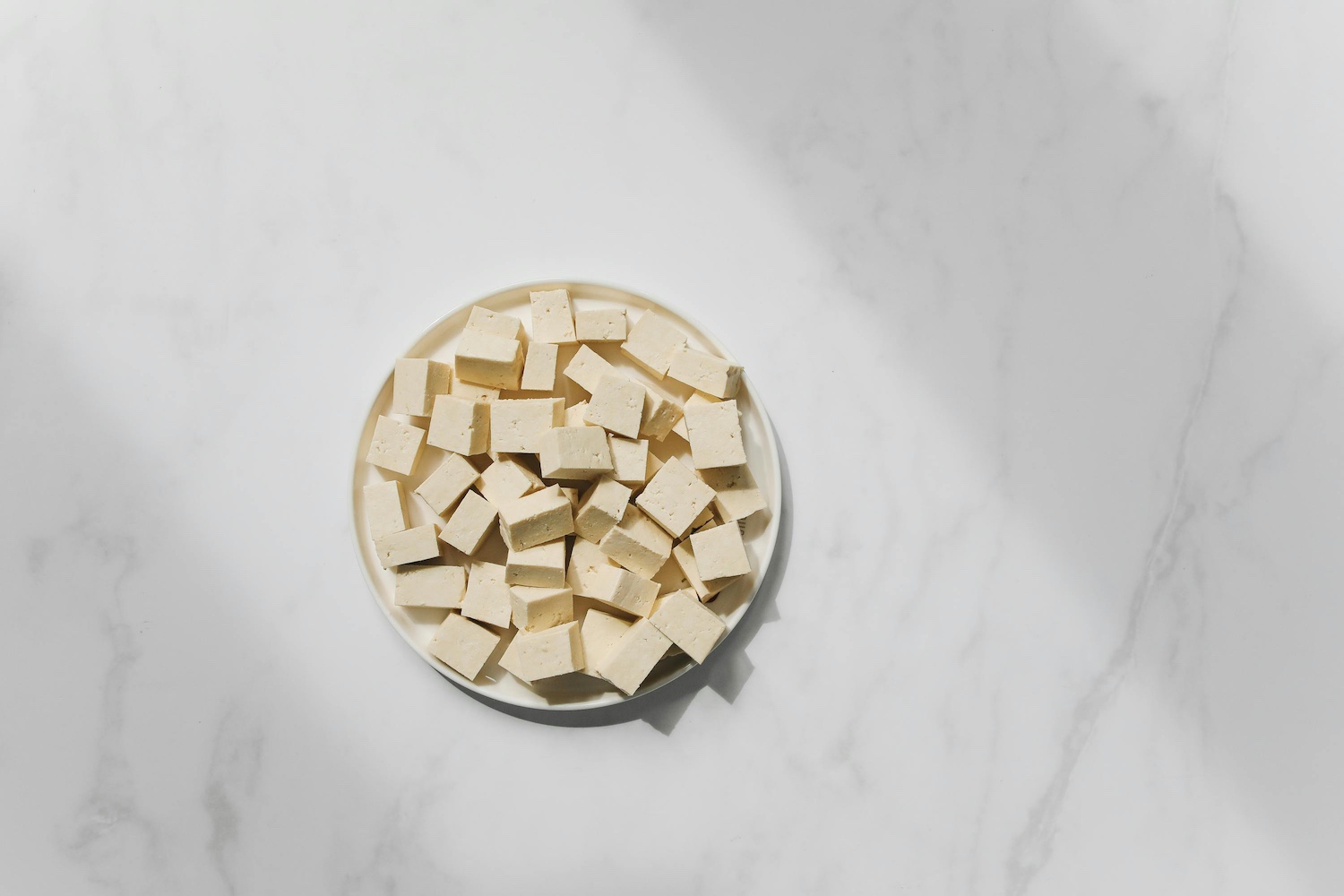Coconut Laksa Recipe
Ingredients
- 2 tbsp organic extra virgin olive oil
- 400 ml organic coconut milk
- 1 litre vegetable stock
- 1 tsp brown sugar
- 250 g tofu
- 1 tbsp organic tamari soya sauce
- 200 g cooked noodles
Ingredients for Laksa Paste (Blend or Finely Chop):
- 2 shallots
- 1 thumb sized piece ginger
- 1 stalk lemongrass
- 2 garlic cloves
- 1 tbsp tamarind
- 1 tbsp fish sauce or plant-based alternative
- 1 tbsp chilli paste
- 1 tsp cumin
- 1 tsp coriander
- 1 tsp turmeric
Instructions: How to Make Coconut Laksa

Step 1: Prepare the Laksa Paste:
Start by chopping the shallots, ginger, lemongrass (just the tender white part), and garlic. These are your flavour ingredients. So don’t rush this step.
Add everything to a blender: the chopped aromatics, tamarind paste, fish sauce (or your favourite vegan swap), chilli paste, ground cumin, coriander, and turmeric.
Blend until it’s all smooth. You want a thick, fragrant paste. If your blender struggles, add a splash of water or olive oil to help it mix everything together. Scrape down the sides to make sure everything is well mixed, because you don’t really want pieces inside the curry.
This paste is what gives your laksa its bold flavour, so you must make sure it’s nicely blended.
Step 2: Heat the Oil
Put a large pan or deep pot over medium heat. Add two tablespoons of olive oil and let it warm up for about 30 seconds. You need the oil hot enough to sizzle gently when you add the paste.
Once the oil is ready, add the laksa paste. You will hear it sizzle straight away. Stir it in and get ready for the smell to fill your kitchen.
Step 3: Cook the Paste
Let the paste cook for 2 or 3 minutes and stir constantly. This helps the spices release their oils and brings out a richer flavour. You’ll notice the paste darken slightly and the smell intensifies.
Be careful not to let it burn. If the heat is too high, we suggest turning it down. This step builds the base flavour for the entire dish, so it’s worth the extra attention.
Step 3: Add Liquids
Next, pour in the coconut milk, vegetable stock, and brown sugar. Use a spoon or spatula to scrape up any browned bits stuck to the bottom. They will dissolve into the soup and add even more flavour.
Stir everything together until the soup has a smooth and creamy colour. Bring it up to a gentle simmer, but don’t boil it. Again, you want it hot enough to bubble a little but not so much that the coconut milk splits.
Let it simmer for 5 minutes to meld the flavours before moving to the next step.
Step 4: Add Tofu and Tamari
Chop the tofu into bite-sized cubes. For extra texture, you can pan-fry the cubes in a little oil until golden on all sides. This adds a bit of chew and stops them from falling apart in the soup.
Stir in the tofu and tamari sauce. The tamari adds a deep umami base and seasons the broth. Let it simmer for another 5 to 10 minutes so the tofu absorbs the flavour and the broth thickens.
Step 5: Add Noodles
If you’re using pre-cooked noodles, rinse them under hot water to loosen them up and separate any clumps. Add them to the pot just before serving and gently stir them through to warm up.
If you let them sit too long, they’ll soak up too much broth and get soggy, so keep that in mind.
If you’re using dried noodles, cook them according to packet instructions, rinse under cold water, then add them at the end the same way.
Step 6: Taste and Finish
Time to taste the broth. And this is the moment to adjust it to your taste.
If it needs more saltiness, add a splash more tamari. If it feels too rich, squeeze in a bit of lime juice to cut through the creaminess. And if you want more heat, stir in some chilli flakes or some chilli paste.

Step 7: Serve
Serve the laksa into warm bowls. Make sure you get a good mix of noodles, tofu, and broth in each one.
Top with whatever you’ve got on hand: fresh coriander, Thai basil, bean sprouts, sliced red onion, lime wedges, or a drizzle of chilli oil. It’s a flexible dish, so you can use what you like. Serve hot, preferably with a spoon and fork or chopsticks.
Tips for Making the Perfect Laksa
Here are a few tips for making a great Laksa, even if that’s your first time. These are optional but just a few tricks.
- Use fresh ginger and lemongrass. Dried versions are great alternatives, but the fresh ingredients give you the clean flavour you want in a laksa.
- Cook your paste properly. Give the paste a couple of minutes to sizzle and it will bring out the full depth of the spices.
- Boil the noodles separately. It stops the soup from going starchy and keeps the noodles from getting too soft.
- Pan-fry the tofu. You need more time but it adds a bit of bite and stops it falling apart in the broth.
- Balance the flavours at the end. Add lime juice, extra tamari, or chilli until you like the taste.
Ingredient Swaps & Variations
If you’re cooking gluten-free, just make sure your noodles and tamari are certified gluten-free. Most are, but it’s always worth double-checking.
For the protein, tofu is the classic choice for a coconut laksa recipe. However there are plenty of options. Tempeh works well if you want something a bit firmer and nuttier. Chickpeas are great too, because they soak up flavour and add some bite.
If you’re not avoiding animal products, soft-boiled eggs or shredded chicken can also be added without changing the base recipe much.
If you can’t get your hands on tamarind paste, you can use lime juice or even some rice vinegar to add that bit of acidity. That cuts through the richness of the coconut milk. The flavour will be slightly different, but still balanced.
Also, you can try mushrooms instead of tofu. Shiitake or oyster mushrooms are especially good in broths like this. You can also toss in cooked lentils, roasted veg, or whatever’s left in the fridge. Again, laksa is a flexible dish.
Lastly, for the noodles, rice vermicelli is traditional, but you can use flat rice noodles, soba, udon, or even whole wheat spaghetti in a pinch.

FAQs
Can I Freeze Coconut laksa?
Yes, you can, but we suggest freezing only the soup. The broth and tofu freeze really well, but the noodles not so much. If you freeze everything together, the noodles will turn to mush when you reheat.
Freeze the broth and tofu in a sealed container, then add freshly cooked noodles when you’re ready to eat. It’ll taste just as good as the first time. Maybe even better after the flavours have had time to sit.
How Long Can I Keep the Laksa in the Fridge?
You can keep the coconut laksa broth (with tofu) in a container in the fridge for a maximum of 3 days. Make sure it’s cooled completely before putting it in the fridge.
When reheating it, warm it on the stove to avoid splitting the coconut milk. If you’ve added noodles already, they’ll soften more over time, so if you’re planning ahead, it’s best to store them separately and add them fresh.
Is Coconut Laksa Vegan?
It’s easy to make laksa vegan. The only non-vegan ingredient is the fish sauce. But you can just swap it for a vegan fish sauce or use more tamari.
Everything else in the recipe is plant-based. You still get all that rich umami flavour from the tamarind, spices, and coconut milk.
If you’re not strictly vegan but avoiding dairy, this recipe is naturally dairy-free too.
Can I Make Coconut Laksa Less Spicy?
Definitely. The chilli paste is what gives it heat, so you can just reduce the amount or leave it out entirely.
If you’re cooking for kids or someone sensitive to spice, you can even serve the chilli on the side so each person can add as much (or as little) as they like. The broth will still be full of flavour from the lemongrass, tamarind, and coconut milk.
Comments & Ratings
Leave a Reply
You must be logged in to post a comment.







delicious!